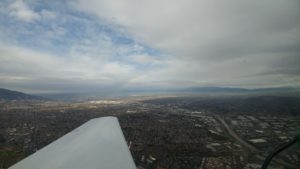Rain, stalls, pattern-work, simulated engine out, and about half a spin…
After two weeks of waiting due to scheduling conflicts with Christmas I got the chance to go fly again. I took Friday off work to try and get in some more training and was crossing my fingers that the weather would work out. The forecast was calling for some rain with the possibility of thunderstorms in the vicinity. As long as the ceilings were high enough and the rain wasn’t too heavy then we would be able to fly. If there were thunderstorms it would be a no-go.
I had gone out Wednesday evening to fuel the plane so that we would be ready to go. As it turned out we weren’t able to leave as early as I wanted because we were waiting for the weather to clear.
I had checked our weight and balance with full tanks and we were going to be forward of the front limits so I bought a couple 50 lb bags of rock salt (put those bags in trash bags for extra protection from any salt dust getting into the carpet) and put those in the baggage area. With the 100 lbs of ballast we would be back in the center of the envelope, we would also be about 125 lbs under gross weight so it would be nice to see how the plane flies when its that heavy.
I had the pre-flight done by the time my CFI arrived and we chatted about the weather, the forecasts, and what it looked like it was going to do. The thunderstorms were not materializing, the overcast was high, and the rain showers were light so we decided to give it a try. We climbed in, buckled up, adjusted seats, and then started the plane. We taxied out to the run-up area and started going through the checklist. As I moved through the run-up checklist I got to the mag check. The right magneto checked fine, but the drop on the left mag was 200 rpm and the max allowed is 125 rpm. My CFI had me run it to 2,200 rpm and lean it out to try and clean up the mag but it still dropped 200 rpm on the check. I told him I remembered reading about that in the POH (Pilot Operating Handbook) so I grabbed it off the back seat and looked it up. We followed the procedure it outlined, idle at 800 rpm for a minute, then slowly increase to 2,200 rpm and recheck. This time the mag check came within limits with a max drop of 100 rpm so we were good to go.
With the plane just under gross weight it took a longer ground roll as expected but it still climbed well. The rain wasn’t much of a factor, it beaded up and ran off the windshield quickly and by the time we were over the practice area it was just about gone. With the overcast and rain it was quiet over Lake Matthews, we had the whole place to ourselves.
We flew around a little as I tried to get a feel for what the site picture is in straight and level flight in the Mooney. After a little flying around and “sight seeing” it was time for some maneuvers. First up was steep turns which went much better than two weeks ago. They were within ACS standards but not yet to my personal standards.
CFI: “Ready for some stalls?”
Me: “Sure… Just be ready.” (We did power off stalls two weeks ago but not power on stalls, and if I got us in trouble I wanted him ready to help out.)
I pulled power back to get my speed down and dropped the landing gear. (Raising and lowering the gear went much better than two weeks ago, I almost look like I know what I’m doing.) With gear down and dropping below 100 mph I put in two pumps on the flaps for take off flap setting. (Power on stalls are supposed to simulate a stall on take off). Once the speed bled all the way down to 70 mph, rotation speed, I advanced the throttle while pulling back on the yoke. Very shortly the stall horn started yelling at us. Quickly after that I started getting the buffeting showing the stall but unlike the power off stall the nose didn’t drop on me. Then I made the mistake of pulling just a tad more on the yoke… The left wing dropped, the right wing started coming over, we were looking straight down at Lake Matthews 2,400′ below, and I was saying “You got it! You got it! You got it!” As soon as we began rolling into the spin he was already reaching for the power and stomping on the right rudder. We went through about half a spin before he brought us out, but it was enough to get both of our attention. There followed a discussion on spin characteristics and recovery. I’ve had the lessons on spin recovery for my PPL, but until you’ve actually been in one, you don’t appreciate it. Sometime I need to go take some actual spin training in a plane rated for spins.
CFI: “You want to try it again?”
Me: “Ok…”
CFI: “You had the stall, but when you tried to get ‘more of a stall’ that was when it got you.”
Me: “Ok, got it.”
The next power on stall was uneventful. I got the full stall with the buffeting and then pushed the yoke forward for a smooth recovery.
Following the stall practice I configured for slow flight and we flew around for about five minutes with the stall horn yelling at us while doing some climbs, descents, and turns. Then it was time to go back and work on some landings and speeds in the pattern.
My landings for the most part were pretty good. That is all except one that he said “Looked really good, right up until it wasn’t…” I am still struggling to get my speed on final approach nailed down. I enter the pattern right at about 100 mph and get down to 90 mph on base, but on final when I should be at 80 mph I am still too fast. I even had one approach that I decided to go around on because I felt I was too fast and too high. The big take-away from today’s flight was “more right rudder” on climb out and while making climbing turns to the right.
After a few more trips around the pattern at Corona we decided to go over to Chino. We took off from runway 7, turned right crosswind, departed the pattern, climbed out, and then made a left turn to head toward Chino. As we made the turn we saw a nice rainbow right over the Corona airport. It really was a beautiful day for flying.
I haven’t been to Chino for a month and a half, and actually haven’t talked to a tower since then either. It’s interesting how changes to routine affect the mind, as well as how new processes can overload the mind. With the simplicity and familiarity of the Cherokee there were many things that came easily from repetition, allowing my mind to focus on other things. The extra thought processes of learning a new plane, trying to stay ahead of it, and not having talked with a tower for awhile would lead to a couple goofs on my part.
As we were approaching Chino it required a conscious effort to say “Mooney 78878” instead of starting the transmission with “Cherokee.” It seemed odd to be landing there in a Mooney after I had landed there over 130 times in a Cherokee. The winds were from 110° at 3 knots but they were still using runways 26R/L so we were landing on 26R with a quartering tail wind. It wasn’t strong, but we could feel it pushing us around a little. I touched us down about 400′ down the runway and instead of getting on the brakes to make the 2000′ turn off I let it roll a little further to the next turn.
Tower: “Mooney 878, any braking issues to report?” (The runway was wet and they wanted information to pass on to other landing planes.)
Me: “No, no issues.” (Then to my CFI) “If it was a rental I could have stood on the brakes and made the first turn.”
CFI: “Hey, that’s not nice.”
Me: “Well it’s true, I’m the one paying for the brakes on this plane.”
We got clearance from ground to taxi back to 26R. After stopping at the hold short line and getting configured for take off I called up the tower, at least I thought I did.
Me: “Chino tower, Mooney 78878, holding short 26R at Papa, requesting right closed traffic.”
Ground: “This is Ground, try asking Tower.” (Dang, I forgot to flip the frequency over.)
Me: (After switching to the correct frequency) “Chino tower, Mooney 78878, holding short 26R at Papa, requesting right closed traffic.”
Tower: “Mooney 78878, cleared for take off runway 26R, extend upwind, expect a 180 turn for landing on 8L.”
Me: “Cleared for takeoff 26R, will extend upwind, expect 180 turn for 8L, 878.” (They were having us fly upwind to allow time to switch runways to land into the wind.)
As we were climbing out my CFI had an idea.
CFI: “Be ready, when he calls the 180 let’s try an engine out and see how you do turning back.”
Me: “You want an engine out turn?”
CFI: “Yeah, give it a try and see how you handle it in this plane.”
We continued to climb out, but the tower wasn’t giving us the turn. I climbed through pattern altitude, 1,400′ and then leveled off at 1,500′.
CFI: “They’re taking longer than I thought.” (Just then)
Tower: “Mooney 878, make 180 right turn, cleared to land 8L.”
Me: “Beginning right 180, cleared to land 8L, 878.” (As I began the turn)
CFI: “Go ahead and pull the power, let’s see what you can do.”
Me: “From this far out?”
CFI: “Yeah, see how it does.” (I began the turn and pulled power.)
CFI: “What’s your best glide speed?”
Me: “105”
CFI: “Okay, pitch for that and no gear or flaps yet.”
We finished the turn angling for the numbers. From where we started about 1,000′ AGL (Above Ground Level) we had more than enough altitude and speed. In fact we were right at the max gear extension speed of 120 mph when I finally dropped the gear, then pulled back to bleed off some speed and put in some flaps. We still ended up landing about 600′ down the runway. It was nice to see how well the plane glides and handles with power out.
After getting taxi clearance back to 8L I stopped at the hold short line and called up the tower. (And made sure I was on the right frequency this time, but I was still about to goof up.)
Me: “Chino tower, Mooney 78878, holding short 86L at Alpha, requesting a south east departure.”
CFI: (Laughing) “You said 86L.”
Me: “I did?” (Apparently looking at the 8L-26R sign my brain put them together, combined with always taking off on runways 26 and never on runway 8 before.)
CFI: “Yep”
Tower: (Who apparently missed my goof or didn’t care) “Mooney 78878, cleared for takeoff runway 8L with a southeast departure.”
Me: “Cleared for takeoff runway 8L and a southeast departure.”
With that we took the runway and were rolling along then lifting off for the short hop back to Corona. I’m 3.2 hours into my transition training and starting to feel a little more comfortable. By the time I get to my 10 hours of dual I think I’ll be ready to fly it solo.

